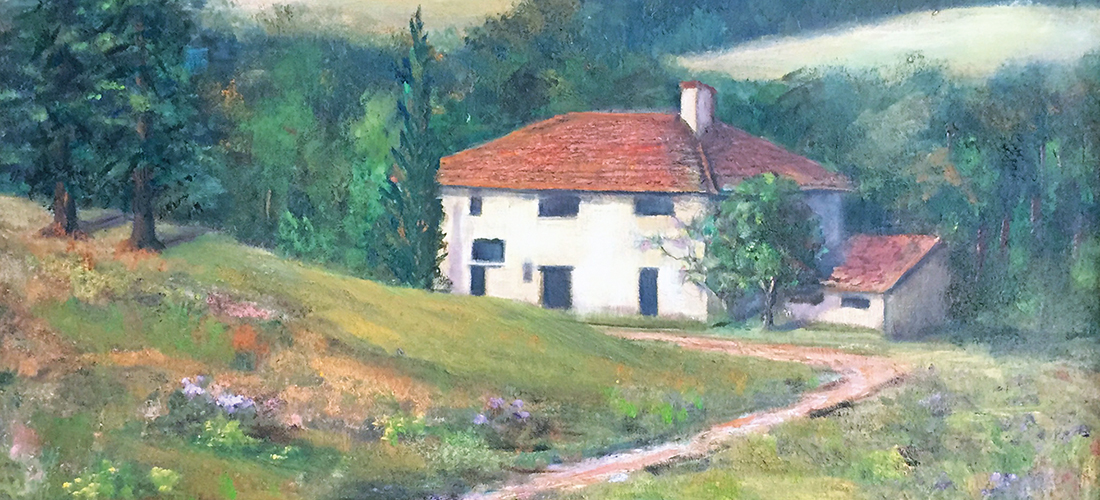By Ash Alder
“Every apple orchard is haunted,” a friend recently offered. “Have you ever noticed? All of them. Day or night.”
I considered the statement, the labyrinths of gnarled trees echoing with distant thuds of falling fruit, autumn’s electric whisper . . .
“I could see that,” I replied.
And yet, having never experienced an orchard in August, when the skin of the earliest apples turns from yellow to green, green to red, the flesh inside from green to white, I wouldn’t know for sure. Could only speculate that the ripening of such autumnal offerings in the sweltering heat of late summer is some kind of omen.
Yes, summer is here. Yet the tangles of wild blackberries will vanish in an instant.
There is movement in the periphery. Always. Perhaps there is something haunting about that.
It is remarkable how closely the history of the apple tree is connected with that of man. — Henry David Thoreau

Flower Mandala
In August, when roadside ditches brim with late summer wildflowers — sweet pea and yarrow and swamp milkweed — pull over.
If you travel with water and a makeshift vase for occasions such as this, handpick a small arrangement for an instant boost in spirit.
And if you’re feeling inspired, dream bigger.
Last year, an hour before sunset, a gardener friend and I met at a favorite climbing tree by a nearby lake to design a flower mandala for the simple joy of creation. I brought a modest handful of black-eyed Susans, some amethyst, a single sunflower. She brought a garden: purple clover, coleus, woolflower, Queen Anne’s lace, fern, walnut, sycamore leaves, and at least a handful of miscellaneous beauties rich in color and texture.
Ancient tools for meditation, mandalas are believed to represent the cosmos, radial designs that guide the creator toward a sense of inner harmony and the essence of his or her own soul.
Ours led us to a space of absolute wonder, and as the final fireflies of summer began dancing among the boughs of our beloved tree, we noticed a small group of passersby that had quietly gathered to enjoy our nature installation — two spirals joined by an unbroken thread of leaves and petals.
We are all so intricately connected. When you follow the simple callings of your heart, no telling how you will color the world.
Bring on the Magic
Among our late summer bloomers: bee balm, a showy yet rugged perennial that blossoms red, pink or lavender. Also called horsemint, Oswego tea and bergamot, its fragrant leaves add notes of citrus and spice to any garden. What’s best? Hummers, bees and butterflies find the flower simply irresistible.
A member of the mint family, bee balm grows best (and spreads!) in full sun. Add its colorful flowers to your summer salad, dry its leaves for tea, and above all, know that your balm is a sweet, tasty tonic for a band of local pollinators.

Spoonful of Sugar Water
A friend recently shared with me a Newsroom 24 article from 2018 that states that without bees, we wouldn’t be alive. “If bees were to disappear from the face of the Earth, says David Attenborough, voice of The Blue Planet and Planet Earth, humans would have just four years to live. He suggests leaving a teaspoon of sugar water in your garden to help energy-depleted bees make it back to the hive. “Simply mix two tablespoons of white, granulated sugar with one tablespoon of water, and place on a spoon for the bee to reach,” says Attenborough. In so many words: Save the bees, save humanity.
Deep summer is when laziness finds respectability. — Sam Keen
The Night Sky
This year, our beloved Perseid meteor shower occurs just two days before the full Sturgeon Moon, creating less than optimal viewing conditions for the annual display of up to 90 shooting stars per hour.
That said, just before dawn on Tuesday, Aug. 13, the moon will set, gifting us with an hour of darkness — a blessed chance to catch a glimpse of the magic.


